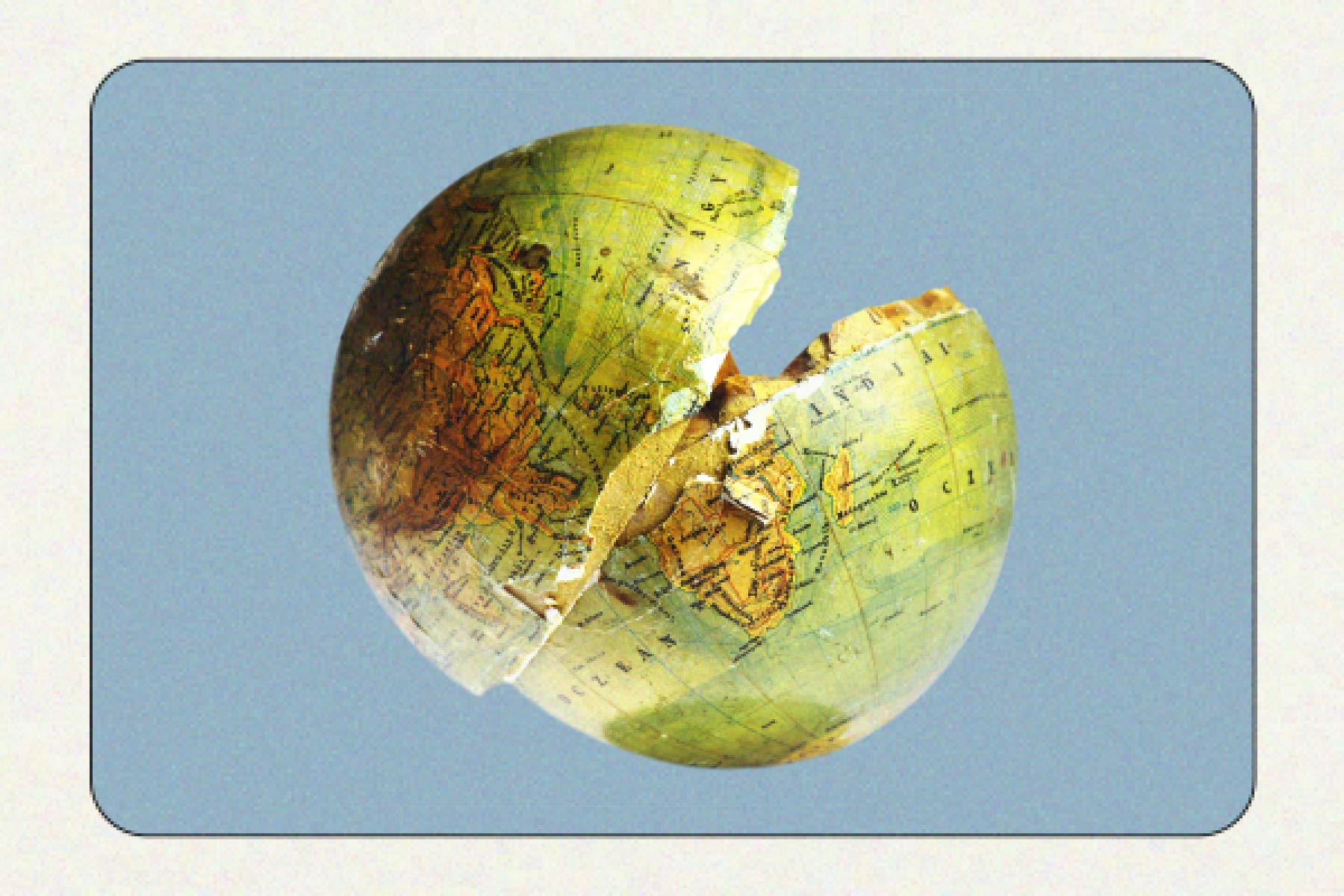The story was charming: a short article about soups, continually replenished for decades, secreted in jars across oceans. The soups, according to one source, were “older than Taylor Swift.” I devoured the article, published in December 2022 on Atlas Obscura, an online publication billed as “best-in-class journalism about hidden places, incredible history, scientific marvels, and gastronomical wonders,” and texted it to a few soup-obsessed friends. Then I forgot about it for months until the weather turned chilly and I pulled up the link again, only to notice the article had changed. An italicized editor’s note had been added to the top, which began: “This article has been retracted as it does not meet Atlas Obscura’s editorial standards.” The note went on to state that multiple details and interviews had been fabricated.
Intrigued, I did a Google search for the author, Blair Mastbaum. His social media profiles and Wikipedia page suggested an American writer in his mid-forties, very active on Instagram, where he posted captionless photos of his travels in Europe. Mastbaum had written ten other articles for Atlas Obscura, eight of which, it turned out, had similar retractions. Topics ranged widely: acoustic archeology, Hawaiian cultural appropriation, an obscure dialect of sign language. Mastbaum’s first retracted story had been published in January 2022; the last one more than a year later.
His final article, from February 2023, was about the Scottish town of Moffat implementing “dark weeks” to protect the night sky from artificial lighting. Except: the townsfolk of Moffat had never done such a thing; experts and locals quoted in the story had never been contacted or interviewed, and at least one does not seem to actually exist. It was an astonishing volume of lies packed neatly into an 1,100-word article. Fiction masquerading as journalism is nothing new, but in the age of Google Alerts and plagiarism checkers, it seems like it ought to be impossible to sustain a year-long series of audacious lies. How can a writer still pull off a con like this? And given the endless opportunities for scamming anonymously, why would anyone undertake such revealing and labour-intensive deceptions?
Founded in 2009, Atlas Obscura is an online publication specializing in descriptions and stories of offbeat destinations, created as the antithesis of the well-trod itineraries offered by popular guidebooks. It has attracted millions of dollars in funding and expanded into a travel planning app, a retail review site, and a food-focused vertical called Gastro Obscura. The editorial mission is to tell true stories that seem, at first glance, to be stranger than fiction, which is perhaps why Mastbaum’s strange fictions seemed so plausible. His stories weren’t outlandish; they were well researched and populated with factual details, with believable quotes attributed to real people. Writing them was at least as much work as reporting truthfully would have been, suggesting they weren’t born of intellectual or professional laziness but some other, more inscrutable, motivation.
It seems likely that everything unravelled with the final article about Moffat, which also bore the longest editor’s note—perhaps Mastbaum had gotten carried away with his ornamental flourishes. One of the sources who denied speaking with Mastbaum, an urban planner from Poland named Agata Łopuszyńska, replied to my message in which I’d asked how she had found out about the article. “That’s a crazy story,” she wrote back. Łopuszyńska learned about the article when a man from a dark-sky organization in the UK emailed to ask her about it. She had never been to Scotland or heard of Mastbaum and was shocked to see quotes, and even photographs included in the article, attributed to her. Soon after other baffled sources reached out to Atlas Obscura, Łopuszyńska was contacted by an editor, who told her about an email exchange between himself and Łopuszyńska that Mastbaum had provided as proof that he had interviewed her. It even included a fake Polish phone number, Łopuszyńska said, which Mastbaum had told Atlas Obscura he had used to contact her on WhatsApp. Łopuszyńska doesn’t use WhatsApp. The email exchange had been fabricated. Most bizarre was a one-word email (“hello”) Łopuszyńska found in her junk folder, sent by Mastbaum two weeks after the story had been published.
Łopuszyńska wished the entire article had been removed from Atlas Obscura’s website, not just appended with an editor’s note. “For me it would be best to no longer see my name in such a scam,” she wrote to me. When I spoke with Samir S. Patel, editor-in-chief of Atlas Obscura, he acknowledged that they had unpublished some of Mastbaum’s stories. “But that’s not proper journalistic practice,” he said. When the errors in the Moffat piece came to light, the website conducted an investigation and temporarily unpublished stories as other issues emerged. Afterward, they republished those stories, without their images and with the addition of editor’s notes. “We want there to be a record,” he explained. It was the same approach taken by the New York Times in 2002, when its editors discovered errors and fabrications in Michael Finkel’s reporting on child slavery in West Africa, and in 2003, when the newspaper discovered that staff reporter Jayson Blair had fabricated details in at least thirty-six stories.
For Patel, a Brooklyn-based science journalist who joined Atlas Obscura in 2017, the incident was perplexing and painful. Mastbaum’s stories didn’t raise any red flags, he said; details were spot-checked by editors, and notes were provided whenever they had questions. They didn’t suspect anything was amiss until a reader reached out to them. Once they realized there were problems with the story, he explained, they did a complete review of all of Mastbaum’s work, reaching out to every single source and documenting the inconsistencies in an editor’s note. According to Patel, Mastbaum ghosted them after the editors notified him of the full review. Patel still stands behind their editorial process. “I wouldn’t say we’ve changed it,” he says. “But I’ll put it this way: it’s changed us a little bit.” They’re a little less trusting than they used to be.
A constellation of online profiles suggests Mastbaum is a lapsed novelist and former copywriter who lives in Europe with his partner, filmmaker Scott Coffey. Coffey is best known for writing and directing the 2005 film Ellie Parker, starring the Australian actress Naomi Watts. When Mastbaum organized a GoFundMe for Coffey’s dental expenses in the summer of 2023, a donor named Naomi Watts contributed $2,000—a detail worthy of a fabulist. On Instagram, Mastbaum documented his travels in the UK and Spain, places that later appeared in his Atlas Obscura stories. Online, it’s easy to glean enough details about a stranger’s life to assemble a vivid but superficial portrait of them—but impossible to map their mysterious interior trajectory, from writing queer coming-of-age novels to publishing fraudulent travel journalism.
Aside from Atlas Obscura, his only significant journalism credit, Mastbaum published similar stories on a now-idle Substack: quirky, detailed digressions into cultural practices and his experiences abroad. Most were about Europe, but one caught my eye because it was about a nation closer to home: the Kwakwaka’wakw tribes of coastal BC. The post included a quote from Jennifer Kramer, an associate professor of anthropology and museum curator at the University of British Columbia. I sent her an email to ask if she had ever spoken with this writer. No, she wrote back quickly, adding, “It is disturbing to learn that he has falsely cited me.” Some details included in the post, Kramer told me, were accurate, while others were completely wrong. I looked up a quote attributed to the famous anthropologist Franz Boas and found that it came from a book by another scholar, written eight years after Boas died. The overall effect of the post was similar to that of one of those AI-generated images of a person with too many fingers: almost but not quite convincing. “Parts of the descriptions stem from accuracy but they have become distorted or read completely wrong to produce stereotypical or offensive results,” Kramer replied. (I ran the Substack post through Copyleaks, an online tool that promises to tell you “with exceptional accuracy” whether a piece of text has been authored by AI. It came back as definitively human.)
Patel said the review of Mastbaum’s reporting by Atlas Obscura editors revealed a similarly confounding mix of fact and fiction. “Some [of his sources] got back to us and said, ‘Yes, this is an accurate reflection of the conversation that I had with this writer.’ Others got back to us and said, ‘I feel like I said this, but I don’t think I said this in this case.’ Or ‘I have said this, but I didn’t talk to this writer and I’ve never heard of this person in my life.’” Two of Mastbaum’s earliest articles passed editorial review, apparently free of falsehoods.
Mastbaum’s stories continue a long tradition of journalistic fabrications, which often involve the distortion of some exotic culture or milieu: Finkel’s falsified reporting on child slavery in West Africa; Stephen Glass’s fictionalized voyage into the heart of a hacker convention; Janet Cooke’s story “Jimmy’s World,” a sordid tale about the eponymous eight-year-old heroin addict that was briefly honoured with a Pulitzer Prize before Cooke’s lies unravelled. There’s a kind of dynamic voyeurism at play, appealing to stereotypes and preconceived ideas, which lends it the quality that Stephen Colbert once described as “truthiness.” The reader feels as though they are peering through a window into the real world, unaware that the very pane of glass they are looking through is warped. The lies themselves are harmful, but so too is our inability to recognize them.
For Nieman Lab, professor and journalist Charlie Beckett writes, “In the wake of all the untrustworthy content online, journalists have forgotten that it used to be axiomatic that ‘you shouldn’t believe what you read in the papers.’” Patel pointed out the same thing to me. “Go back a hundred years . . . and people took journalism with a grain of salt,” he said. “Then there was a period where journalists were really trusted and seen as gatekeepers—the Cronkite era.” Now we’re back in a cynical phase: in 2023, the Reuters Institute Digital News Report found only 37 percent of English-speaking Canadians trust the news.
It’s not a bad thing that we’re more skeptical of the media, that we challenge what confronts us with questions. The problem is that skepticism itself does not equip us to distinguish between fact and fiction. In 2019, almost 40 percent of surveyed Canadians admitted in an Ipsos poll that they had been suckered at least once by fake news, a percentage that perhaps not coincidentally spiked with the advent of AI tools like Midjourney and DALL-E 3, which can produce increasingly realistic-looking images. And after another year of layoffs that continued to decimate the hollowed-out media industry, it’s also harder for media organizations to stay on top of. Patel acknowledged that Atlas Obscura relies on editors to check articles, but few outlets allocate a budget or time to dedicated fact checking.
Distrust of mainstream media is one reason why a growing number of people are relying on social media, like TikTok, as a primary source of news, despite the fact that platforms are rife with misinformation: a 2022 investigation by NewsGuard found that one in five search results on TikTok contained false claims. But examples of misinformation spawn indiscriminately across platforms, because they share a fundamental structure: they are designed to incentivize engagement. It’s a technological expression of the fabricator’s logic—a hierarchy of attention over accuracy.
Mastbaum’s fabrications were convincing for the same reason any fakery is: burnished with captivating details and memorable quotes, they were almost better than real. Why a middle-aged former novelist would craft such elaborate fabrications and lies about old broth for fifty cents a word is harder to answer. Mastbaum didn’t respond to my emails or DMs on Instagram for comment, but I didn’t really expect him to. He knows as well as I do that the real explanation could never be as interesting as a story.





